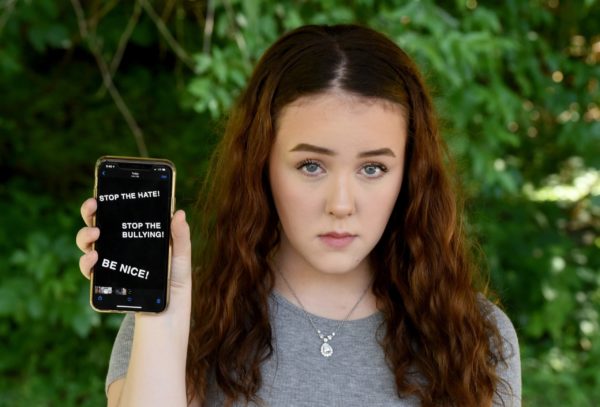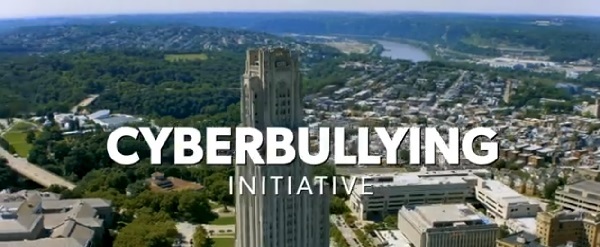
What you should know about cyberbullying: It’s on the rise amid the pandemic.
Tatum suffered from cyberbullying from middle school through high school. Photo by Philip Pavely.
Tatum was in middle school when the cyberbullying started. Unflattering photos appeared on Snapchat and Instagram, fake accounts posted under her name and she was included on the “ugliest 8th-grade girls” list in her school district.
By the time she reached high school, “it got really bad,” says Tatum, who is a recent high school graduate. At the time, she let her teachers and school counselors know. They told her not to be a tattletale. Her mom called the school to complain, but there was never any action taken against the offenders because the bullying took place online.
Instead, it was suggested to Tatum that she was at fault and might need counseling.
“I was diagnosed with anxiety and depression, just from all of these girls bullying me for no reason,” Tatum says. “I’d never done anything to them.”

Cyberbullying upsurge
Cyberbullying affects approximately 36.5 percent of all kids between the ages of 12 and 17, according to surveys conducted by the Cyberbullying Research Center. Adolescent girls are more likely to experience cyberbullying than their male counterparts, with hurtful comments and false rumors the most common forms of cyber harassment.
Bullying has long been an issue for kids and parents. But the advent of technology brings a new dimension to the taunts, verbal abuse and threats that are the hallmarks of bullying. Social media platforms and interactive gaming open the window to bullies.
And now, the pandemic adds another element. With kids spending more time at home and on screens, cyberbullying is on the rise. According to L1ght, an organization that monitors online harassment and hate speech, cyberbullying has increased by as much as 70 percent in a matter of months.
Bullying “looks a lot different now than when we were growing up,” says Ryan Klingensmith, founder of Shape the Sky, the Pittsburgh nonprofit that promotes education to enrich online experiences for kids. His training courses are directed at parents to help them catch up with their kids’ online proficiency.
“Even from 15 to 20 years ago, when a computer was in the living room or somewhere parents could keep an eye on it, it’s basically changed from there,” he says.
Because most kids now have cell phones and are often one step ahead of their parents in terms of technology, the effects of cyberbullying might not immediately be noticeable. Some of the signs to look for include a nervous preoccupation with text messages, being wary of sharing information they found online with parents and displaying anger and depression after online sessions.
Another sign is using their devices less frequently, Klingensmith says “The thing with cyberbullying is even if you put the device down, it doesn’t stop happening. If you put the device down for two days, then you have to go back and read two days’ worth of messages.”

Anxiety and depression
Technology can provide adolescents with connections and safe online spaces that are especially important during the COVID-19 pandemic, says Dr. Ana Radovic of UPMC’s Division of Adolescent and Young Adult Health. When those connections are compromised by cyberbullying or negative online experiences, anxiety and depression can increase.
Another thing to note: The victims of cyberbullying are not the only ones who are at risk.
“Kids who are bullied or are bullies themselves are more likely to have mental health problems,” Radovic says. “That prompts me to ask if they’re depressed, if they’ve any thoughts of suicide or whether they’re having problems with social anxiety. Kids who are on the autism spectrum are more likely to be bullied, so it’s important that those things that are difficulties for them are being addressed.”
Avoid confronting or responding to cyberbullies, she adds.
“Unfortunately, the bully probably lacks insight into why they are behaving the way that they are,” Radovic says. “People who bully tend to have behavioral problems, have substance abuse and they might have less social support and might have been a prior target themselves.”
Klingensmith agrees that engaging bullies is not the best strategy. Instead, parents should take screenshots of interactions and keep track of how a child is using technology, whether it’s Instagram, Snapchat or other social media platforms.
Parents should also think about reining in their kids’ technology access. Klingensmith has met kids as young as 10 years old who have the latest iPhones and are resistant to any restrictions or interference because they are worried their parents – who may be unfamiliar with a platform — will make things worse.
“You have to be a digital parent with your kids,” Klingensmith says. “A lot of parents don’t want to do that, but a lot of parents are willing to give a kid an unsupervised device.”
Rising above the bullies
With help from a counselor, Tatum eventually recovered from the trauma inflicted on her by cyberbullies. The counselor reminded Tatum that her family loved her. She came to realize that even though some of her friends had abandoned her, cyberbullying wasn’t going to define her life.
The counselor “told me that it wasn’t going to hurt me in the long run and it shouldn’t hurt me now,” says Tatum, who starts college this year. “She wasn’t dismissing it, but she said I wouldn’t care about it in 10 years. That really helped.”
Tatum admits the cyberbullying continued through high school. But she was able to sweep the taunts and mean comments under the rug. They no longer affected her. And even though no one – the bullies, teachers or administrators – apologized to her, Tatum graduated from high school with increased confidence and self-worth.
Tatum acknowledges that for anyone being cyberbullied, it seems like the end of the world.
“But in about five years, you’re going to be a lot stronger from these experiences,” she says. “And I kind of want to thank those girls for saying those things about me because they gave me a thicker skin. I am able to take criticism with a grain of salt now.”
Cyberbullying Resources
Shape the Sky: This Pittsburgh-based organization advocates for better education and communication for kids’ online experiences. Follow on Facebook for tips and notices of frequent webinars for kids and parents.
Common Sense Media: The independent nonprofit researches and reports on all matter of media to help guide parents through the ever-changing landscape of media. The section on cyberbullying offers advice and insight.
Pitt Cyber: The University of Pittsburgh site features cyberbullying resources.
Stop Bullying: A US government clearinghouse for cyberbullying information.
Cyberbullying Research Center: A comprehensive site that offers statistics, workshops and other resources to combat cyberbullying.
The Trevor Project: This resource focuses on LGBTQ kids dealing with bullying.
Pitt Cyber research
Researchers from the University of Pittsburgh’s Pitt Cyber recently interviewed students from middle schools in Western Pennsylvania about cyberbullying. Pitt research is building on AT&T’s Upstander Program for high school kids to develop a similar program for middle schoolers. Here’s some of the feedback received from students.
- The most severe forms of cyberbullying included offensive or hurtful comments about race, politics, or religion.
- Parents don’t understand cyberbullying because they hadn’t experienced it and weren’t familiar with the platforms.
- Cyberbullying is a big problem, but sometimes not for them personally or at their school. Kids in different schools saw different levels of consequences for those involved in bullying.
- Some kids develop their own strategies to prevent cyberbullying, mainly by deleting apps or blocking certain users.
- Reaching out to friends, family and teachers or school administrators was seen as a good strategy, but with reservations. Kids worried that friends in their own schools might spread rumors and felt more comfortable talking to kids in other school districts. They worried that talking to parents might result in consequences and preferred to speak with older cousins or siblings. Some kids thought teachers or school counselors might not keep their information private.
This story is part of the Kidsburgh Mental Health Series, funded by a grant from the Staunton Farm Foundation. The Foundation is dedicated to improving the lives of people who live with mental illness and/or substance use disorders. The Foundation’s vision is to invest in a future where behavioral health is understood, supported, and accepted.
Other stories in the series include the Kidsburgh Mental Health Survey report, insight as to how parents can deal with coronavirus anxiety, and advice on remaining resilient during times that try your family’s mental health. Check out the fascinating look at the teenage brain. Other stories include Anchorpoint Counseling Ministry’s hugely successful fundraiser, the secret to happy, successful kids and looking to Fred Rogers for help in talking to kids about life’s most challenging issues. Don’t miss how practicing mindfulness helps kids ease anxiety and the way teens Stand Together Against the Stigma.


